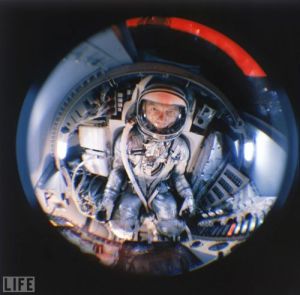 Tomorrow marks the 50th anniversary of John Glenn’s Friendship 7 flight. The first orbital mission of the Mercury program, which launched on February 20, 1962, was a major achievement for NASA and a significant milestone to the American people. The flight marked the US finally matching the Soviet Union in space and was a major step towards the lunar landing goal Kennedy had set the year before.
Tomorrow marks the 50th anniversary of John Glenn’s Friendship 7 flight. The first orbital mission of the Mercury program, which launched on February 20, 1962, was a major achievement for NASA and a significant milestone to the American people. The flight marked the US finally matching the Soviet Union in space and was a major step towards the lunar landing goal Kennedy had set the year before.
My article commemorating the mission will appear tomorrow on Scientific American’s Guest Blog, but I thought it might be fun to share some of the interesting facts and bizarre finds I came across during my research. (Left, Glenn trains in a simulator. 1959.)
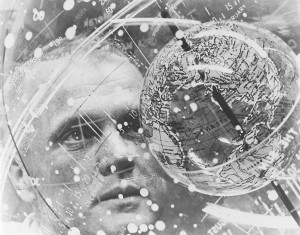 When NASA announced the Friendship 7 flight the launch date was set for January 16, 1962. But problems with the Atlas’ fuel tanks and adverse weather pushed the launch back over a month. By the time launch day came — finally with clear skies — some worried that Glenn was overtrained. He wasn’t. The formal ruling on his preparedness in the post mission report said that the extra time had given him a greater familiarity with the spacecraft’s systems and vital training in launch abort procedures. During Mercury, an escape tower would pull the capsule free from an exploding rocket. The resulting hard land landing was something Glenn and the other Mercury astronauts were very happy to never experience. (Right, Glenn studies a globe at the aeromedical laboratory.)
When NASA announced the Friendship 7 flight the launch date was set for January 16, 1962. But problems with the Atlas’ fuel tanks and adverse weather pushed the launch back over a month. By the time launch day came — finally with clear skies — some worried that Glenn was overtrained. He wasn’t. The formal ruling on his preparedness in the post mission report said that the extra time had given him a greater familiarity with the spacecraft’s systems and vital training in launch abort procedures. During Mercury, an escape tower would pull the capsule free from an exploding rocket. The resulting hard land landing was something Glenn and the other Mercury astronauts were very happy to never experience. (Right, Glenn studies a globe at the aeromedical laboratory.)
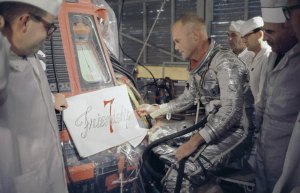 When it came to naming the capsule, Glenn got his children involved. He asked them to consider some names on one condition: it had to represent the country and the way we feel about the rest of the world. His son Dave and daughter Lyn wrote down what they thought were appropriate words from a thesaurus: Columbia, endeavour, America, Magellan, we, hope, harmony, and kindness. Friendship was on top of the list, and Glenn loved it. He had the artist at Cape Canaveral paint the name in script to set it apart from the block letters that decorated his predecessors’ spacecraft. (Left, Glenn okays the artwork for his Friendship 7 spacecraft.)
When it came to naming the capsule, Glenn got his children involved. He asked them to consider some names on one condition: it had to represent the country and the way we feel about the rest of the world. His son Dave and daughter Lyn wrote down what they thought were appropriate words from a thesaurus: Columbia, endeavour, America, Magellan, we, hope, harmony, and kindness. Friendship was on top of the list, and Glenn loved it. He had the artist at Cape Canaveral paint the name in script to set it apart from the block letters that decorated his predecessors’ spacecraft. (Left, Glenn okays the artwork for his Friendship 7 spacecraft.)
Four hours and 55 minutes after launch, Glenn splashed down in the Atlantic Ocean. In a previous post about splashdowns — regular readers know that landing methods are a favourite topic of mine — I estimated that over 8,000 men were on hand to assist in Glenn’s recovery. It turns out that my estimate was far too conservative. There were 15,600 men involved in the recovery operations for Glenn’s flight. 15,600!
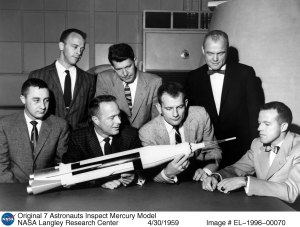 Moving from the past to the present, it’s been interesting to read the articles celebrating Glenn and Friendship 7 this past week. Most chronicle the historic flight or else sing the praises of this national treasure, but few put Glenn within the context of the Mercury program or NASA as a whole.Though this might only seem like an oversight to an historian. I won’t cover that here (that would give away tomorrow’s aritcle), but the theme of heroics without context did make me think about what John Glenn means to the average American (and Canadian) today. (Right, the Mercury astronauts pose with a model rocket in 1959. This picture will be relevant further down.)
Moving from the past to the present, it’s been interesting to read the articles celebrating Glenn and Friendship 7 this past week. Most chronicle the historic flight or else sing the praises of this national treasure, but few put Glenn within the context of the Mercury program or NASA as a whole.Though this might only seem like an oversight to an historian. I won’t cover that here (that would give away tomorrow’s aritcle), but the theme of heroics without context did make me think about what John Glenn means to the average American (and Canadian) today. (Right, the Mercury astronauts pose with a model rocket in 1959. This picture will be relevant further down.)
Informal polls yielded interesting results. Glenn made people think of: elementary schools, bravery, The Right Stuff, Ed Harris, the Moon, Apollo 13, astronauts, Neil Armstrong, spaceflight, role models, Buzz Aldrin, NASA, the space program, and being awesome.
‘Hero’ was, by far, the most common response.
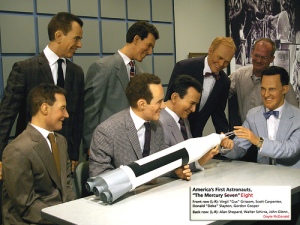 And like any national hero, Glenn has been immortalized in more than just books and movies. There are some really interesting renditions of the astronaut in museums and collections.
And like any national hero, Glenn has been immortalized in more than just books and movies. There are some really interesting renditions of the astronaut in museums and collections.
The image on the left shows wax figures of the seven Mercury astronauts inspecting a rocket with an interesting paint scheme. The manic smiles and wide eyes on their faces are frightening to say the least. Particularly Grissom who looks far too excited by a model rocket and Carpenter whose eyes are focused off into the distance. This is, I assume, modeled after the previous image, though none were smiling like this in the original.
 Another wax tribute to NASA’s first astronaut corps in the Denver Wax Museum captures the spirit of the program. All seven astronauts are in some kind of space station. Glenn floats above the rest while Slayton is unsmiling; perhaps because he never got to fly a Mercury mission. Carpenter, depicted climbing out of a hatch, seems to be looking longingly into the eyes of a colleague. In all cases, they’re virtually unrecognizable. (Right, the wax Carpenter.)
Another wax tribute to NASA’s first astronaut corps in the Denver Wax Museum captures the spirit of the program. All seven astronauts are in some kind of space station. Glenn floats above the rest while Slayton is unsmiling; perhaps because he never got to fly a Mercury mission. Carpenter, depicted climbing out of a hatch, seems to be looking longingly into the eyes of a colleague. In all cases, they’re virtually unrecognizable. (Right, the wax Carpenter.)
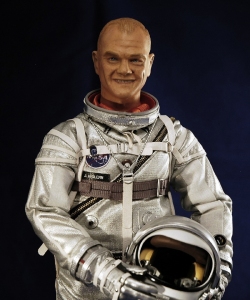 John Glenn action figures are not uncommon either. Custom figurines are available online, like this model. The detail is exquisite, but the face looks like the stuff of nightmares. To be fair, few people look good on a 1:6 scale and sculpting a face that small is not easy.
John Glenn action figures are not uncommon either. Custom figurines are available online, like this model. The detail is exquisite, but the face looks like the stuff of nightmares. To be fair, few people look good on a 1:6 scale and sculpting a face that small is not easy.
I’m sure there are thousands more instances of strange memorabilia, old and new, depicting the Mercury astronauts. The culture surrounding the first manned spaceflight program goes well beyond men on the covers of magazines. Shampoo came in mini Apollo command module and space food sticks were available in grocery stores. And if the 50th anniversary of Glenn’s flight is any indication, there’s no shortage of reverence for the nation’s first astronauts a half century later.

Cheers Asteitel!
Thanks.
I’ll hang the flags tomorrow, hopefully the sun will shine and we’ll have blue sky.
Amy, the smiling astronauts version of the photo does exist and is here: http://cdn.theatlantic.com/static/infocus/mercury022111/s_m03_gs622704.jpg (first I could find)
(although there is a lot less weirdness in their smiles but I guess that is due to the ‘talent’ of the waxworker.)
Amy, I’m aware of the GI Joe Mercury figure, the Hot Wheels John Glenn return to space set and a resin model of Glenn beside a model Mercury capsule (a model of a model, like a doll’s house in a doll’s house!) but don’t recognise the photo of the 1/6th Glenn figure. Can you point me at the source, please?